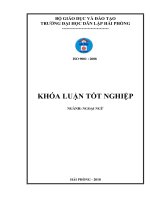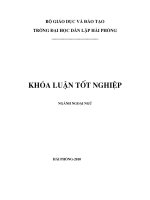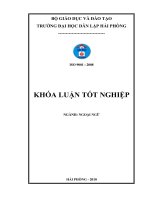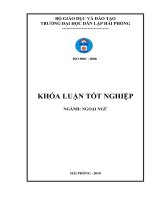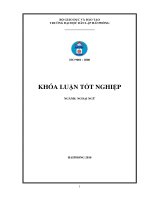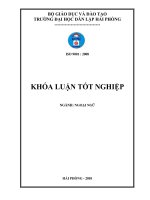A study on homonyms in English
Bạn đang xem bản rút gọn của tài liệu. Xem và tải ngay bản đầy đủ của tài liệu tại đây (678.34 KB, 79 trang )
1
ACKNOWLEDGMENTS
In order to fulfill this graduation paper, I have received a lot of help, advice,
encouragement and supports from many of my teachers, relatives and friends.
First of all, I wish to express my deep gratitude to my supervisor Mrs. Dao Thi
Lan Huong for her valuable advice, comments, encouragement and whole-
hearted direction from the beginning to the finishing. Her supports have also
helped me a lot during the time I wrote this graduation paper
Secondly, I would also be grateful to Mrs. Tran Ngoc Lien, Dean of Foreign
Language Department and all the teachers of Foreign Language Department of
Haiphong Private University who taught me for the past four years.
In the process of writing this graduation paper, I also want to express special
thanks to all my friends, for their highly valuable encouragement and support for
my study.
Finally, my overriding depth continues to be expressed to my lovely family
members who always stand by me to help me to overcome every difficulty in
completing this task.
Student
Le Thi Phuong Cham
Class 903
2
TABLE OF CONTENTS
Acknowledgments
Abbreviation
PART I: INTRODUCTION Page
I.
Rationale
1
II.
Aims of the study
2
III.
Scope of the study
2
IV.
Method of the study
2
V.
Design of the study
3
PART II: DEVELOPMENT
CHAPTER I: THEORETICAL BACKGROUND
I.
Words
4
1.
Definitions of words
4
2.
Types of words
5
1.1.
Simple words
5
1.2.
Derived words
6
1.3.
Compound words
6
II.
Word meaning
6
1.
Definitions of meaning
6
2.
Types of meaning
8
3
2.1.
Lexical meaning
9
2.1.1.
Direct meaning
9
2.1.2.
Indirect meaning
10
2.2.
Grammatical meaning
10
CHAPTER II: HOMONYMS IN ENGLISH
I.
Definitions of homonyms
14
II.
Classification of homonyms
17
1.
The main ways of classification
17
1.1.
Classification given by I.V.Arnold
17
1.1.1.
Homonyms proper
18
1.1.2.
Homophones
19
1.1.3.
Homographs
21
1.2.
Classification given by A.I.Smirnitsky
23
1.2.1.
Full homonyms
24
1.2.2.
Partial homonyms
24
2.
Other ways of classification
25
2.1.
Lexical homonyms
25
2.2.
Grammatical homonyms
26
III.
Sources of homonyms
26
1.
Phonetic changes
26
4
2.
Borrowings
26
3.
Word-building
27
4.
Disintegration or split of polysemy
28
IV.
Problems of homonyms
33
CHAPTER III: IMPLICATION OF THE STUDY
I.
Commonly misused pairs of homonyms
36
II.
Exercises
41
PART III: CONCLUSION 47
References
Appendix:
I.
Keys to exercises
II
Homonyms list
5
ABBREVIATION
Adj or A
Adjective
Adv
Adverb
Cf.
Confer
Cj
Conjunction
N
Noun
O.E.
Old English
O.F.
Old French
Prp
Preposition
Past indef.
Past indefinite
Past part.
Past participle
V
Verb
6
PART I: INTRODUCTION
I. Rationale
There are many special phenomena in English, for example: “She is a bee”. It
does not mean she is a bee - one kind of animal but here, it does mean she is a
very hard-working person. This phenomenon is called metaphor. It borrows
characteristic of animal to show personalities of persons. Similarly, in daily life,
there are some cases which make us have confusion or misunderstanding like
the following funny story:
Policeman: (holding up his hand) Stop!
Visitor: What is the matter?
(P: policeman; V: visitor)
P: Why are you driving on the right side of the road?
V: Do you want me to drive on the wrong side?
P: You were driving on the wrong side.
V: But you said that I was driving on the right side.
P: That is right! You are on the right and that is wrong.
V: A strange country! If right is wrong, I am right when I am on the wrong side,
so why did you stop me?
P: My dear sir! You must keep to the left. The right is the left.
V: It is like a looking glass. Could you tell me the way to Bellwood?
P: Certainly! At the end of this road, then turn left.
V: Let me think! In England, left is right and right is wrong. Am I right?
P: You will be right if you turn left but if you turn right, you will wrong.
(Truong, 1993: 89)
7
The funny story above have just shown us a very interesting phenomenon in
English – homonymy. Only one word “right” has the same sound and spelling
but different in meaning. One is right side and one is correct, it caused confusion
in communication between Policeman and Visitor. The phenomenon, which
sometimes makes us confusing and misunderstanding in communication by the
same spelling and may be the same sound but different meaning, is the reason
explaining why the writer of this graduation paper decided to choose the study
“homonyms in English” and hopes that it will be useful to learners of English.
II. Aims of the study
This paper tried to provide English learners information about:
1. Definitions of homonyms in English.
2. Classification of homonyms.
3. Sources of homonyms
4. Problems of homonyms
5. Some pairs of homonyms which English learners often make mistake.
6. Some exercises. (with keys)
7. Homonyms list
III. Scope of the study
Homonyms is a problem that learners concern about in which there are many
typical aspects such as equivelances of English and Vietnamese homonyms,
misused pairs of homonyms However, due to the limit of time and knowledge,
the writer cannot study all the matters relating to homonyms. As mentioned
above, in this paper, the writer only studies on definitions, classification, sources
and its problems. Especially, the author pays much attention to classification of
homonyms.
IV. Methods of the study
To achieve the aims of the study successfully and effectively, in the studying
8
process, the author stored knowledge from a lot different kinds of sources
specialized in English homonyms. This study is fulfilled due to the information
collected from different sources to give the theorical background such as
introduction about words and word meaning. Then, an analysis on homonymy in
English including definitions of homonyms, classification, sources and its
problems is used. After that, the implication is discussed for a better knowledge
of homonyms to avoid misunderstanding when learning especially in
communication.
V. Design of the study
This study consists of three parts in which the second is the most important.
Part I: Introduction, which states the reason of the study, the aims of the study,
the scope of the study, the methods of the study and the design of the study.
Part II: Development: The main content including three chapters:
The first chapter is the theoretical background. It focuses on some general
definitions about lexicology, words, and word meaning which relate to
homonyms.
The second chapter stresses on homonyms in English including definitions,
classification, sources and its problems.
The last one gives some pairs of homonyms which English learners easily make
mistakes. In this chapter, some exercises are also provided to help learners avoid
ambiguity when seeing them.
Part III: is the conclusion of the whole study that summarizes the topic discussed
in Part II.
In addition, homonyms list is also given in appendix part at the aims of helping
learners refer them in studying process.
9
PART II: DEVELOPMENT
CHAPTER I: THEORETICAL BACKGROUND
I. WORDS
1. Definitions of the words
In order to understand what is a word? At first, we need to know what is
lexicology? Lexicology (from Lexiko-, in the Late Greek Lexicon) is the part of
linguistics, which studies words, their nature and meaning, words‟ elements,
relations between words (semantical relations), words groups and the whole
lexicon.
(from Wikipedia, the free encyclopedia)
According to Greek, lexis means words and logos means study or science of
words. So, lexicology is a study or science of words. The word is, therefore, the
central important element in lexicology.
The term “word” is used to specify an intermediate structure which is smaller
than a whole phrase and yet generally larger than single sound segment.
Therefore, word may be defined differently.
First, word is a unit of speech that, as such, serves the purposes of human
communication. Thus, word can be defined as a unit of communication.
Secondly, the word, viewed structurally, possesses several characteristics.
According to Jackson and Amvela (2005:50), word is considered “an
uninterruptible unit of structure consisting of one or more morphemes and which
typically occurs in the structure of phrase”. The morphemes are the ultimate
grammatical constituents, the minimal meaningful units of language. For
example, the different forms of the verb “learn”, i.e. learn, learns, learning,
learnt are separated words grammatically; similarly, the plural, the plural
possessive and the possessive of the word “baby”, all are represented by the
pronunciation /beibiz/ but spelt babies, babies‟, baby‟s respectively.
10
According to Hung (2006:3), word is defined as “a speech unit used for the
purposes of human communication, materially representing a group of sounds,
possessing a meaning, susceptible to grammatical employment and
characterized by formal and semantic unity”.
According to Truong (1993:11), word is defined “A word is a dialectical unit of
form and content, independent unit of language to form a sentence by itself”; for
example, “book, bookish, go, eat, ” and so on. Each word here can stand
independently and it still has meaning.
In general, there are many ways to define word. Word may be defined
differently depending on whether the focus on its representation, the thought
which it expresses or purely formal criteria. Word can be defined basing on the
phonological, lexical, grammatical points of view and semantics. However, the
definition of word according to Truong (1993:11) seems to be the most
satisfactory.
Words in English can be classified the lexical and grammatical words. Lexical
words including nouns, verbs, adjectives, adverbs have fairly independent
meaning and may be meaningful even in isolation or in a series. It also referred
to a “lexeme”. A lexeme is a lexical unit of the vocabulary. The term “lexeme”
is sometimes used to denote a lexical word and this helps avoiding confusion
with the term “word” in general. In contrast, grammatical words including
articles, prepositions, and conjunctions, forms indicating number or tense and so
on do not automatically suggest any identifiable meaning.
2. Types of words
Truong can classify Word into three types: simple words, derived words and
compound words.
2.1. Simple words
A simple word is one that only consists of a root morpheme:
E.g.: Table, boy, small
11
2.2 Derived words
A derived word is one that consists of a root and one or more derivational
morphemes:
E.g.: Teacher, interesting
2.3. Compound words
A compound word is one that has at least two roots, with or without affixational
morphemes:
E.g.: blackboard, lady-killer, merry-go-round
Words are often considered linguistic sign, similar to natural and conventional
signs. They do not have meaning but rather are capable of conveying meanings
to those who can perceive, identify and interpret. Words go together to form
sentences which are capable of conveying meanings-the meanings of the
individual words and the meaning that comes from the relation of those words to
one another. According to De Saussure (1959), the linguistic “sign” is a mental
unit including two faces, which cannot be separated: a concept and an acoustic
image. The term “sign” is quite a general expression that can refer to sentences,
clauses, phrases, words or morphemes. De Saussure pointed out that an
alteration in the acoustic image must make a difference in the concept and vice
versa. Since the word is a linguistic sign, a discussion of “word meaning”
focuses on the relationship between the two faces of the sign.
II. WORD MEANING
1. Definitions of meaning
The question “What is meaning” is one of those questions that are easier to ask
than answer. The linguistic science at present is not able to put forward a
definition of meaning which is conclusive.
However, there are certain facts of which we can be reasonably sure, and one of
them is that the very function of the word as a unit of communication is made
12
possible by its possessing a meaning. Therefore, among the world‟s various
characteristic, meaning is certainly the most important.
Generally speaking, meaning can be more or less described as a component of
the word through which a concept is communicated, in this way endowing the
word with the ability of denoting real objects, qualities, actions and abstract
notions.
(Hung, 2006:43)
More carefully analyzed, the word “meaning” is derived from the verb “mean”
and both of them are used like many other English words, in a wide range of
contexts and in several distinguishable senses. For example, to take the case of
the verb, if somebody says:
(1) Smith means well
(Hoa, 2001:7)
She or he implies that Smith is well intentioned, that he intends to harm.
(2) That red flag means danger
(Hoa, 2001:7)
In saying this, one would not normally be implying that the flag had plans to
endanger anyone; one would be pointing out that it is being used to indicate that
there is danger in the surrounding environment, such as the use of explosives in
a nearby quarry or deep lakes. Similar to the red flag use of the verb “mean”, in
one respect at least is its use in:
(3) Smoke means fire
(Hoa, 2001:8)
In both (2) and (3) one thing is said to be a sign of something else: from the
presence of the sign, are flag or smoke, anyone with the requisite knowledge can
infer the existence of what it signifies, danger or fire, as the case may be.
13
However, there is also an important difference between (2) and (3). Whereas
smoke is a natural sign of fire, causally connected with what is signifies, the red
flag is a conventional sign of danger: it is a culturally established symbol.
(4) „Soporific‟ means „tending to produce sleep‟
(Hoa, 2001:8)
The word „soporific‟ is narrowly used and in this saying, the speaker wants to
use common words in the phrase „tending to produce sleep‟ to help the others
understand easily the meaning of „soporific‟. Therefore, this is quite important
in giving the meaning of a word. Like in this case:
(5) What does „capitalist‟ mean to you?
(Hoa, 2001:8)
„Mean‟ in this sentence implies that „what does „capitalist‟ convey to you‟. After
all, we can see that there are many different meanings of the word „mean‟. It
follows that, if semantics is defined as the study of meaning in language, there
will be many differences but interesting, branches of semantics.
2. Types of meaning
Some tigers are roaring at the mouth of the cave.
(Truong, 1993:86)
The above is a meaningful part. One of the smaller parts is the word „tiger‟ that
refers to a certain animal. We call it is a referring expression. A referring
expression is a piece of language that is used as if it is linked something outside
language, some living or dead entities or concepts. Another meaningful part is
the verb „roar‟ which is also linked to something outside of language, an activity
here associated with the referring expression „tiger‟. We call this meaningful
part a predicate that clarify something about that entity. Besides, the plural form
of the noun „tiger‟ indicating that there is more than a tiger and the tense of the
verb „roar‟ pointing out the time of this action. Obviously, in a sentence, two
kinds of meaning are remained: lexical meaning, in case of the noun „tiger‟, the
14
verb‟ roar‟ and grammatical meaning (also called functional meaning) in the
plural form of the noun as well as the tense of the verb.
2.1. Lexical meaning
Lexical meaning is one of two types of meanings found in words. Lexical
meaning is the individual meaning each word has in the system of language. It is
the realization of concept and emotion and brings together the different forms of
the same word.
(Truong, 1993:53)
When we hear or see the word house for example, our concept is realized and
the picture or image of the house occurs to our mind. Therefore, this realization
is called lexical meaning. On the other hand, the work doctor, it refers to person
why works in hospital in order to treat patients. Lexical meaning is dived into
two types. They are direct meaning and indirect meaning.
2.1.1. Direct meaning
Direct meaning is the meaning that directly denotes something without
comparing it or associating with other things, i.e. we do not need a context.
Direct meaning is also called literal meaning.
(Truong, 1993:57)
E.g. 1: where is the key for turning off the radiator?
(No, 1993:1113)
The word key here is a small instrument using to open or close the door, or to
start or stop the engine of a vehicle.
E.g. 2: He fell and hit his head.
Or The ball hit her on the head.
(No, 1993: 935)
The word head is the part of the body containing the eyes, nose, mouth and
brain. Etc. We need not the comparison or association with other things to
15
understand it. Therefore, head in this sentence is direct meaning. It differs from
indirect meaning which is discussed in the following.
2.1.2. Indirect meaning
Indirect meaning is the meaning that indirectly denotes something. To
understand it we have to compare it or associate with other things, i.e. we need
contexts. Indirect meaning is also called “figurative/transferred meaning”.
(Truong, 1993:57)
On hearing the word „key‟ for example, we are most likely to think of a small
metal instrument using to open or lock the door.
This is the direct meaning of „key‟. On the other hand, if we come across the
sentence. “He said that always listening to other ideas is the key to success”, we
will think of the meaning of „the way to gain the success in life‟, which is an
indirect meaning.
It happens the same with the word head in the sentence „He is the head of the
class‟. We will think of meaning of leader. We can see that head with direct
meaning is a part of the body, it can control people‟s behaviors and actions, but
head with indirect meaning of leader is the person who controls activities of a
class to help it develops. Besides, there are many other direct meanings of head
such as person in the sentence: „I count 29 heads at the party‟ and beginning in
the sentence: „The head step planned‟.
Therefore, we can infer that to understand direct meaning, we need not the
comparison but to understand indirect meaning, we need the comparison with
direct meaning.
2.2. Grammatical meaning
Grammatical meaning can be defined as an expression in speech of relation
between words based on the contrastive features of arrangement in which they
occur. This meaning is abstract and generalized. (Truong, 1993:53)
16
Every language has a grammatical system and different language has some-what
different grammatical systems. We can explain what grammatical meanings are
by showing how the sentence „some students are listening to music‟ differs from
other sentences that have the same or a similar, referring expression and the
same predicate. The grammatical system of English makes possible the
expression of meanings like these:
Statement vs. Question:
Some students are listening to music Are some students listening to music
Affirmative vs. negative:
Some students are listening to music Some students are not listening to music
Present continuous vs. past
Some students are listening to music Some students listened to music
Plural vs. singular
Some students are listening to music A student is listening to music
Indefinite vs. definite
Some students are listening to music The students are listening to music
From the above comparison, we can conclude that grammatical meanings are
expressed in various ways: the arrangement of words (referring to expression
before the predicate, for instance), by grammatical affixes like the –s attached to
the noun “student” and the –ed attached to the verb “listen”, and by grammatical
words or functional words, like the ones illustrated in those sentences: be (in the
form are), not, some, the. These words do not automatically suggest any
identifiable meaning. They are elements like preposition, articles, and
conjunctions, forms indicating number or tense, and so on.
Let‟s consider the forms:
a) Eat, eating, ate, eaten
b) Put up with, kick the budget, dog in the manger
17
c) Listen, speak, read, write
How many words are there in the group a)? Four or one? There are four forms
and the four forms have different meaning, but they have a shared meaning,
which is lexical and other meaning of a grammatical nature added to the lexical
meaning. Then we say that different forms of the word will share the same
lexical meaning but different grammatical meanings.
Group b) presents a different sort of problem. The expression “put up with”
combines the forms of “put”, “up”, and “with”, but its meaning is not the
combination of their separate meaning. Therefore, “put up with”, in the sense of
“endure”, “tolerate” is a single word. The same in the cases of “kick the budget”
which means “die” and dog in the manger when it refers to a person who will
not let others share what he has, even though he does not use it himself. Here we
find that some lexical words and functional words are put together to form a new
meaning word.
In group c), all of those words are verbs but each word denotes a different
action. Therefore, different words may share the same grammatical meaning but
different lexical meanings.
Besides, full word forms, which are forms of the major part of speech, such as
nouns, verbs and adjectives have both lexical and grammatical meaning. For
example, child and children, being forms of the same lexeme “child” have the
same lexical meaning. When the lexemes have certain semantic relevant
grammatical properties (it is a noun of particular kind), the two word-forms also
share some parts of categorical meaning. Difference between singular and plural
(in those languages in which it is grammaticalised) is another part of the
categorical component of grammatical meaning. For example, the word “father”,
it has lexical meaning (male, parent) and also grammatical meaning (singular,
count noun, it can play the function of subject, object, complement)
All in all, lexical and grammatical meanings do not exist separately but always
go together to make up the meaning of the word
18
CHAPTER II: HOMONYMS IN ENGLISH
Language processing considerations have often been used to explain aspects of
language structure and evolution. According to Bates and MacWhinney, this
view "is a kind of linguistic Darwinism, an argument that languages look the
way they do for functional or adaptive reasons". However, as in adaptationist
accounts of biological structures and evolution, this approach can lead to the
creation of "just so" stories. In order to avoid these problems, case-by-case
analyses must be replaced by statistical investigations of linguistic corpora. In
addition, independent evidence for the relative "adaptiveness" of certain
linguistic structures must be obtained. We will use this approach to study a
linguistic phenomenon - homonymy. That seems to be maladaptive both
intuitively and empirically and has been frequently subjected to informal
adaptationist arguments. A statistical analysis of English homonyms then
uncovered a reliable bias against the usage of homonyms from the same
grammatical class. A subsequent experiment provided independent evidence that
such homonyms are in fact more confusing than those from different
grammatical classes.
In a simple code each sign has only one meaning, and each meaning is
associated with only one sign. This one-to-one relationship is not realized in
natural languages. When several related meanings are associated with the same
group of sounds within one part of speech, the word is called polysemantic,
when two or more unrelated meanings are associated with the same form - the
words are homonyms.
The intense development of homonymy in the English language is obviously
due not to one single factor but to several interrelated causes, such as the
monosyllabic character of English and its analytic structure.
The abundance of homonyms is also closely connected with such a
characteristic feature of the English language as the phonetic identity of word
and stem or, in other words, the predominance of free forms among the most
19
frequent roots. It is quite obvious that if the frequency of words stands in some
inverse relationship to their length, the monosyllabic words will be the most
frequent. Moreover, as the most frequent words are also highly polysemantic, it
is only natural that they develop meanings, which in the course of time may
deviate very far from the central one.
In general, homonymy is intentionally sought to provoke positive, negative or
awkward connotations. Concerning the selection of initials, homonymy with
shortened words serves the purpose of manipulation. The demotivated process
of a shortened word hereby leads to re-motivation. The form is homonymously
identical with an already lexicalized linguistic unit, which makes it easier to
pronounce or recall, thus standing out from the majority of acronyms. This
homonymous unit has a secondary semantic relation to the linguistic unit.
Homonymy of names functions as personified metaphor with the result that the
homonymous name leads to abstraction. The resultant new word coincides in its
phonological realization with an existing word in English. However, there is no
logical connection between the meaning of the acronym and the meaning of the
already existing word, which explains a great part of the humor it produces.
In the course of time the number of homonyms on the whole increases, although
occasionally the conflict of homonyms ends in word loss.
I. DEFINITIONS OF HOMONYMS
There are many definitions of homonyms in English as the following:
In linguistics, a homonym is one of a group of words that share the same
spelling and the same pronunciation but have different meanings, usually as a
result of the two words having different origins. The state of being a homonym
is called homonymy.
(
One of two or more words that have the same sound and often the same spelling
but differ in meaning. Definition of Dictionary.com


